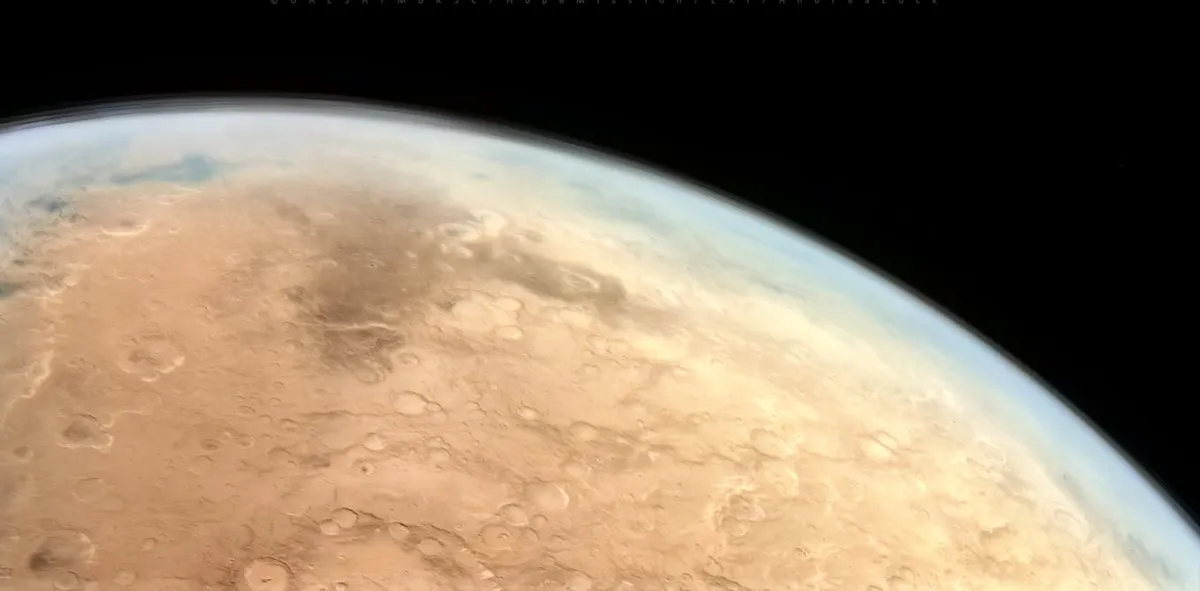
Evidence is mounting that a secret lies beneath the dusty red plains of Mars, one that could redefine our view of the Red Planet: a vast reservoir of liquid water, locked deep in the crust. Mars is covered in traces of ancient bodies of water, but the puzzle of exactly where it all went when the planet turned cold and dry has long intrigued scientists. Our new study may offer an answer.
Using seismic data from NASA’s InSight mission, we uncovered evidence that the seismic waves slow down in a layer between 5.4 and 8 kilometres below the surface. This phenomenon could indicate the presence of liquid water at these depths. Mars wasn’t always the barren desert we see today; billions of years ago, during the Noachian and Hesperian periods (4.1 billion to 3 billion years ago), rivers carved valleys and lakes shimmered in the sunlight.
As Mars’ magnetic field faded and its atmosphere thinned, most surface water vanished. Some escaped into space, while others froze in polar caps or were trapped in minerals, where they remain today. However, evaporation, freezing, and mineral binding can’t fully account for all the water that must have once covered Mars. Calculations suggest that the “missing” water could be sufficient to cover the planet in an ocean at least 700 metres deep, and potentially up to 900 metres deep.
One hypothesis is that the missing water seeped into the crust. Mars experienced heavy bombardment by meteorites during the Noachian period, which may have formed fractures that allowed water to channel underground. In the planet's deeper layers, warmer temperatures would maintain the water in a liquid state, unlike the frozen layers closer to the surface.
In 2018, NASA’s InSight lander touched down on Mars to study the planet’s interior with a super-sensitive seismometer. By examining a specific type of vibration known as “shear waves,” we discovered a significant underground anomaly: a layer between 5.4 and 8 kilometres deep where these vibrations travel more slowly. This “low-velocity layer” is likely composed of highly porous rock filled with liquid water, akin to a saturated sponge or the aquifers found on Earth.
Our calculations suggest that the “aquifer layer” on Mars could contain enough water to cover the planet in a global ocean ranging from 520 to 780 metres deep—several times more than the amount of water held in Antarctica’s ice sheet. This volume aligns with estimates of Mars’ “missing” water, which ranges from 710 to 920 metres, after accounting for losses to space, water bound in minerals, and modern ice caps.
Our groundbreaking discovery was made possible by two significant meteorite impacts in 2021 (designated S1000a and S1094b) and a marsquake in 2022 (named S1222a). These events generated seismic waves that rippled through the crust, similar to dropping a stone into a pond and observing the waves spread. The InSight seismometer captured these vibrations, and we utilized the high-frequency signals from these events—akin to tuning into a crisp, high-definition radio station—to map the crust’s hidden layers.
By calculating “receiver functions”—the signatures of these waves as they bounce and reverberate between layers in the crust—we were able to identify boundaries where rock changes, revealing the water-soaked layer located 5.4 to 8 kilometres deep.
Liquid water is essential for life as we know it. On Earth, microbes thrive in deep, water-filled rock. Could similar life forms, perhaps remnants of ancient Martian ecosystems, still exist within these underground reservoirs? This discovery also holds promise for future human exploration. Purified water from these reservoirs could provide drinking water, oxygen, or even fuel for rockets.
However, drilling kilometres deep on a distant planet presents a daunting challenge. Our data, collected near Mars’ equator, also suggests the potential existence of other water-rich zones, such as the icy mud reservoir of Utopia Planitia.
Currently, our seismic data covers only a fraction of Mars. New missions equipped with seismometers are essential to map potential water layers across the rest of the planet. Future rovers or drilling missions may eventually tap into these reservoirs, analyzing their chemistry for signs of life. Additionally, these water zones require protection from Earthly microbes to safeguard any native Martian biology that may exist.
For now, the presence of liquid water beneath Mars invites us to keep listening to the planet’s seismic heartbeat, as we unravel the secrets of a world that may be more like Earth than we ever imagined.